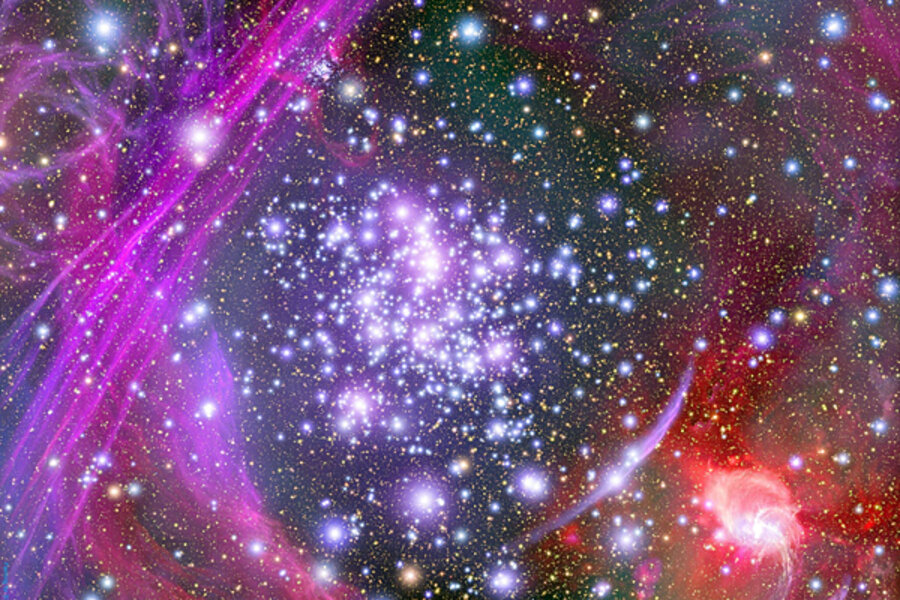Other Earths? A new estimate raises the odds of finding them.
Loading...
The prospects for finding Earth-sized planets around other sun-like stars in the Milky Way appear to be improving.
A new estimate predicts that for every four sun-like stars, one should host at least one planet with anywhere from one-half to twice Earth's mass.
The estimate was among the results of a study by an international research team commissioned by NASA to identify potential targets for as-yet unbuilt space telescopes.
The study, which will appear in Friday's issue of the journal Science, doesn't directly address the Holy Grail for planet hunters – finding an Earth-size planet at a life-sustaining distance from its host star. The researchers' prediction involves Earth-size objects in orbits that would fall well inside the orbit of Mercury, the inhospitable first rock from the sun. Their estimate was based on careful observations of stars from a volcano-based telescope in Hawaii.
But if Earth-scale planets are present at the distance the study's researchers predict, it would imply a greater likelihood that such objects would be present in more-distant orbits as well – including within a star's so-called habitable zone, they say.
At the least, such close-in objects would be among the first Earth-size planets NASA's Kepler mission is expected to detect. The Kepler spacecraft, which was launched in March 2009 and trails Earth in its orbit around the sun, is designed to detect Earth-size planets in "life-friendly orbits" around distant stars.
If the international research team's prediction holds up, Kepler, in addition to the planets it is already looking for, would also find as many as 260 of the star-hugging Earths the researchers predict.
"This is a first estimate," cautions Andrew Howard, a University of California at Berkeley astronomer who, along with Berkeley colleague Geoffery Marcy, led the effort, which NASA commissioned five years ago as it contemplated a new generation of space telescopes for studying planets in other solar systems. "The real number could be one in eight instead of one in four. But it's not one in 100, which is glorious news."
Plenty of targets
The results suggest that if those proposed space telescopes get beyond the stage of Powerpoint slides, astronomers will have plenty of targets, relatively nearby, to observe.
Such observations also would add to a growing body of evidence that current theories about how solar systems form, particularly how planets wind up in their final orbits, are either incomplete or wrong, some astronomers say.
As those theories stand now, they suggest that the close-in regions occupied by these Earths and other planets the team detected should be relatively planet-free.
Instead, they are populated with planets ranging from Jupiter- and Neptune-size objects to so-called super-Earths, with five to 30 times Earth's mass. Based on a statistical analysis of the masses of planets at a given orbital distance, the team calculated that 23 percent of sun-like stars should host an Earth-size planet.
Other astronomers have tried to develop similar estimates, notes Ray Jayawardana, an astronomer at the University of Toronto who was not involved with the project. But this team's attempt at a census of extrasolar planets and the relative abundance of planets of various sizes is the most rigorous to date, he adds.
The estimate is based on a five-year effort to detect planets around 166 sun-like stars within 80 light-years of Earth. The vast majority of extrasolar planets found so far have been so-called hot Jupiters – massive planets whose orbit times often are measured in a handful of days. Using the 10-meter Keck Telescope atop Hawaii's Mauna Kea volcano, the researchers detected the planets by watching for subtle back-and-forth shifts in a star's spectrum that an orbiting planet imparts.
Of the stars the team surveyed, 22 hosted a combined 33 detectable planets with orbital periods no longer than 50 days.
The team's analysis showed that out of each 100 sun-like stars, as few as two would host a Jupiter-mass planet, six would host planets comparable to Neptunes, and 12 would have super-Earths.
Planets defy theory
Even if the team's predictions for truly Earth-size planets fail to pan out, the detected planets pose a conundrum, Dr. Jayawardana says.
Planets form from a broad disk of dust, gas, and ice that encircles their star.
Computer simulations of this process suggest that if planets actually form in or close to the orbits in which the team found its samples, rocky planets will either continue to grow into monstrous gas giants, or they will quickly interact with any remaining disk in ways that send them slowly spiraling into their star.
"Either way, you shouldn't get a lot of intermediate-mass planets at these kinds of orbits," he says.
But, according to the team's observations, there they are.





